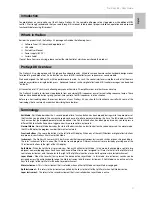
User’s Manual – ambiotex
ambiotex GmbH
Page 11 of 15
Heart rate variability
The interval of two heartbeats is usually determined by successive R waves, the so-called RR
interval. At a closer look, you will notice that the duration of intervals normally differ in a
millisecond range. (See next figure). The intervals‘ behavior determines the heart rate variability.
This irregularity is mainly caused by normal respiration. Try it yourself: Feel your pulse and take a
deep, steady breath in and out. You will notice that while inhaling your heart rate is increasing,
whereas on exhalation the heart rate is decreasing.
This capacity to adapt to the breathing rate is controlled by the vegetative or autonomic nervous
system via parasympathetic and sympathetic activation. This system in our body is responsible for
recovery and regeneration. If the sympathetic nervous system activates due to stress or over
training, the heart rate will not change while breathing and the heart rate variability will decrease
accordingly.
Our stress level particularly measures the parasympathetic activation and compares it to the
reference values of people of the same age and same sex at similar daytime and under normal
conditions. The stress level 5 applies to this reference value. In other words, achieving a value
below 5 means that you are more relaxed than average, whereas achieving a value above 5 means
that you are more stressed than average.
Please be aware, that your value will be added up within a 5-minute period. If you are
standing up or walking during that period, the value will be changed due to your
changing activity and the elevated pulse rate related to it. As a result, the calculation
of your heart rate variability will be modified.

































